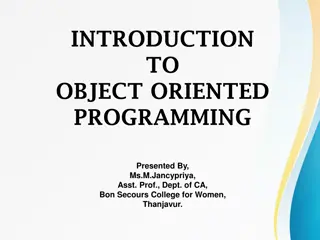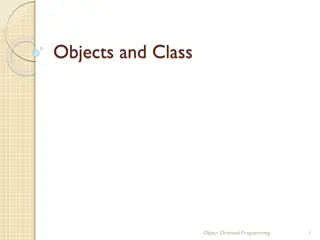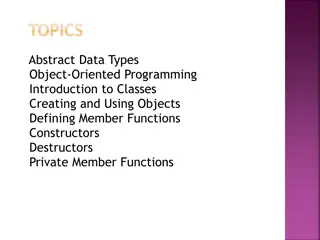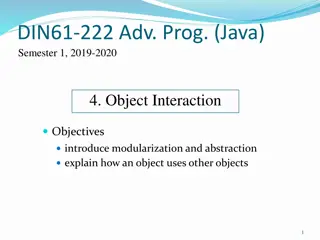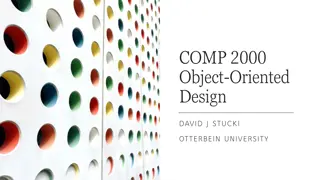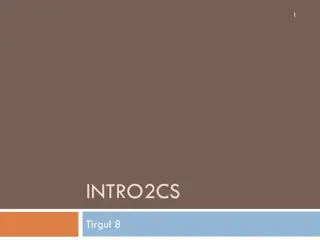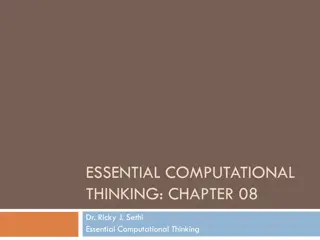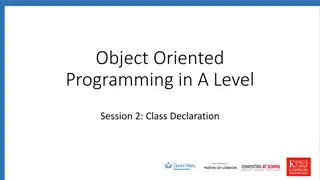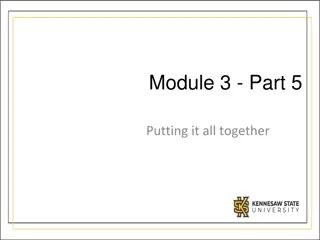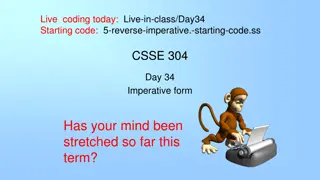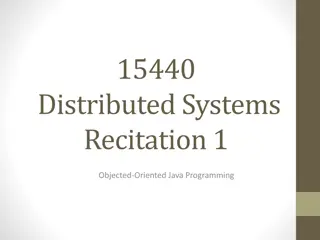Exploring Object-Oriented Programming in Scheme
The content discusses implementing object-oriented programming concepts in Scheme, focusing on encapsulation through fields and methods. It explores representing objects and manipulating fields exclusively through methods. The tutorial covers creating objects, defining methods, and accessing fields within a functional language setting.
Download Presentation

Please find below an Image/Link to download the presentation.
The content on the website is provided AS IS for your information and personal use only. It may not be sold, licensed, or shared on other websites without obtaining consent from the author. Download presentation by click this link. If you encounter any issues during the download, it is possible that the publisher has removed the file from their server.
E N D
Presentation Transcript
CSSE 304 Day 9 Two A6/A7 solutions "OOP" in Scheme? ArrayList exercise Live coding today! You may want to get the starting code from live-in-class/Day09-array-list
Scheme-a-thon is Done! Congratulations. You made it through! 3 assignments this week (7b today, 8 Wednesday, 9 Friday) 1 week 4 (A10 due after the break, Thursday January 7) 3 week 5 (A11a, A11b (team) , A12 (written, no code) 2 week 6 (A13 (team), A14 (team)) 2 week 7 (A15, A16 (team)) 1 week 8 (A17a (team)) 2 week 9 (A17b (team), A18a (team)) 2 week 10 (A18b (team), A 19)
http://community.schemewiki.org/?object-oriented-programming Constructing objects "fields" "methods" method arguments HOW MIGHT WE DO OOP IN SCHEME, USING ONLY THINGS THAT WE HAVE SEEN SO FAR?
"OO Programming" in Scheme We need to find a way to encapsulate "fields" and "methods", so that fields can only be accessed/changed by using the methods. We can represent an object by a _____. "Fields" are persistent local variables. A "method name" is the first argument to the "object" procedure "method arguments" are the other arguments to the procedure.
> (define s1 (make-stack)) > (define s2 (make-stack)) > (s1 'push 'a) > (s2 'push 'z) > (s1 'push 'b) > (s1 'pop) b (s1 'empty?) #f > (s2 'push (s1 'pop)) > (s1 'empty?) #t > (s2 'pop) a > (s2 'pop) z > (s2 'pop) Exception in car: () is not a pair > Transcript that illustrates the use of the stack "class" A better error message would be a nice improvement here
Encapsulation: Creating "objects" in a mostly functional language The car of the stk list contains the top of the stack This code contains a What is the problem with this code? subtle error. Can you see what it is? How to fix it?
Encapsulation: Creating "objects" in a mostly functional language The car of the stk list contains the top of the stack This code contains a Reverse these two code lines What is the problem with this code? subtle error. Can you see what it is? How to fix it?
HW 8 Preview You will implement another class, slist-leaf-iterator. Your procedure, given an s-list s, will make an iterator "object" that iterates the symbols in s. An easy way to implement this? Good idea?
HW 8 Preview You will use this stack "class" as a helper procedure in your implementation of another class, slist-leaf-iterator. Your procedure, make-slist-leaf- iterator, given an s-list s, will make an iterator "object" for s. Why is the "easy" approach from the last slide inefficient? Think of an s-list with tens of thousands of symbols. In the HW problem, your iterator procedures are not allowed to traverse more of the tree than is required for the 'next calls that actually happen. That's where a stack object comes in. Can be similar to the preorder iterator in Weiss*, Chapter 18. * Data Structures and Problem Solving Using Java But the code will be simpler than Weiss s because Scheme notation is simpler.
An ArrayList class Let s make a class that has some of the functionality of the Java ArrayList class. For starters: implement constructor, (add obj), (add obj n) Needed fields? Initial values? What to do when there s no room to add another object? Let s write some code!


